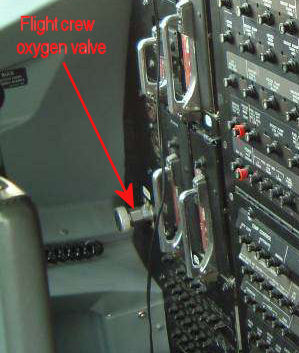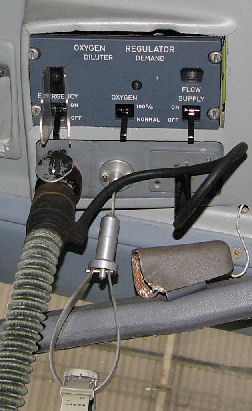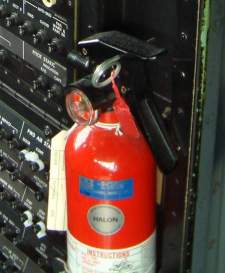 Emergency Equipment
Emergency Equipment
Contents
Contents
All of the information, photographs & schematics from this website and much more is now available in a 374 page printed book or in electronic format.
*** Updated 05 Aug 2023 ***
| ||
Contents
|
Contents |
All of the information, photographs & schematics from this website and much more is now available in a 374 page printed book or in electronic format. *** Updated 05 Aug 2023 *** |
Flight Crew OxygenWhen conducting the oxygen mask flow & intercom check, monitor the crew oxygen pressure gauge to ensure a steady flow as any fluctuations may be due to an obstruction in the system. Give a long check of the flow on the first flight of the day in case the crew oxygen shut off valve has been closed. A short check may sound OK but you may be hearing the residual oxygen left in the lines rather than fresh oxygen from the bottle. |
|||||||||||||||||||||||||||||||||||||||||||||||||||||||

Oxygen Panel -300+ |
 Oxygen Panel -1/200
|
||||||||||||||||||||||||||||||||||||||||||||||||||||||
 |
Crew Oxygen Shutoff Valve (Not installed on NG's) The F/O should ensure that the crew oxygen shutoff valve, located at the bottom outside of the P6 panel, is open (anticlockwise) and ideally backed off by half a turn to avoid damage to the seal. This should be done during the cockpit preparation, particularly in airlines where it is the practice to close this valve overnight. |
||||||||||||||||||||||||||||||||||||||||||||||||||||||
|
Crew oxygen pressure on aft overhead panel should be checked against MEL 35-1 or FPPM 2.2.14. The minimum despatch quantity varies with size of bottle, bottle temp and number of flightdeck crew. The minimum amount of oxygen is based upon one hour of normal flight at a cabin altitude of 8000ft for one pilot with the diluter set to NORMAL (76 cu ft bottle). |
||||||||||||||||||||||||||||||||||||||||||||||||||||||
|
Crew oxygen is stored in a bottle in the forward hold. On older aircraft (pre 1990 ish) there is a servicing point on the outside (see photo below) however on most access is gained through the forward hold. All aircraft have a green oxygen overboard discharge indicator disc on the overboard vent, located on the outside fuselage, adjacent to the crew oxygen cylinder in the forward hold. This is to warn crew if oxygen has been lost through the vent due to an over pressure discharge. This should be checked on every walkaround.
Oxygen Servicing Point on Lower Fwd Fuselage
|
|||||||||||||||||||||||||||||||||||||||||||||||||||||||

737-1/500 Oxygen Mask Deployed
|
Flight Crew Oxygen Mask
The oxygen regulator has three modes: Normal: Red latch on left is up - Gives air/oxygen mix on demand. Use if no fumes are present eg decompression. 100%: Push red latch on left down - Gives 100& oxygen on demand. Use if smoke or fumes are present. Emergency: Rotate red knob clockwise - Gives 100% oxygen under pressure. Used to clear mask & goggles of fumes and should also be used if aircraft is depressurised above 39,000ft. |
||||||||||||||||||||||||||||||||||||||||||||||||||||||
 737-200 crew oxy panel |
|||||||||||||||||||||||||||||||||||||||||||||||||||||||

Passenger Service Unit - PSU
|
Passenger OxygenClassics & NG's: Will deploy automatically above 14,000ft cabin alt or when switched on from the aft overhead panel. No oxygen will flow in a PSU until a mask in that PSU has been pulled. Passenger oxygen should not be used as smoke hoods as the air inhaled is a mixture of oxygen and cabin air and there is a significant fire hazard with oxygen in the cabin. There is 12 minutes supply of oxygen in each PSU, this is based upon:
Passenger oxygen on 737-1/200's is supplied by two oxygen bottles in the forward hold. The capacity varies with operator but is typically 76.5 cu ft each. Oxygen bottle pressure is indicated on the aft overhead panel. |
||||||||||||||||||||||||||||||||||||||||||||||||||||||

Aft Attendant Panel
|
|
||||||||||||||||||||||||||||||||||||||||||||||||||||||
Life JacketDo not inflate until you are outside the aircraft as it will impede your exit and you could puncture it as you leave.
|
|||||||||||||||||||||||||||||||||||||||||||||||||||||||

Cockpit Fire ExtinguisherIs BCF and works by removing oxygen from the fire triangle of oxygen - heat - fuel. As it does not directly cool the fire, when oxygen returns, so could the fire. To operate, remove ring and press down on top lever. Hold upright and beware, BCF fumes are toxic. |
|||||||||||||||||||||||||||||||||||||||||||||||||||||||

|
SlideServiceability check includes the pressure gauge. Tip: Be extremely careful to remember to disarm any door slides you may have armed on flights without cabin crew eg ferry flights or air-tests. Note that the slides are not certified as emergency floatation equipment although Boeing say that an inflated slide could be buoyant, and useful as a floatation device and handgrips are positioned along the sides of the slide. | ||||||||||||||||||||||||||||||||||||||||||||||||||||||